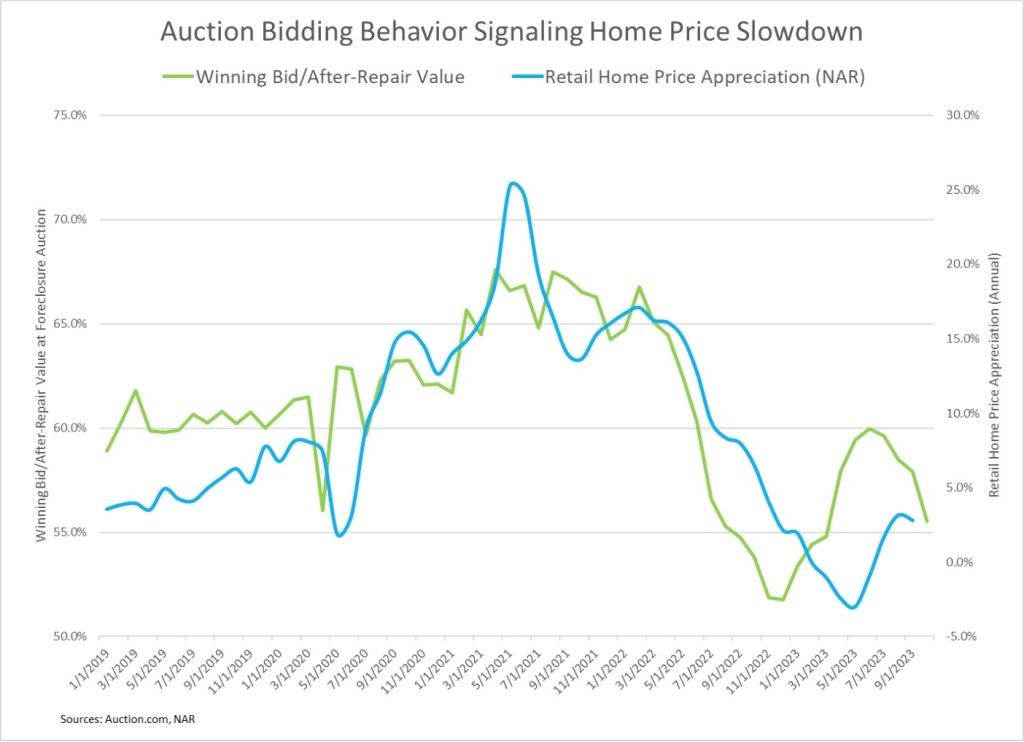Local community developers bidding on foreclosures in the second half of 2023 are signaling a slowdown in U.S. home price appreciation in the first half of 2024, with a rising risk that appreciation will dip back into negative territory. The risk of a double dip in home price appreciation varies substantially by market, even among some markets in the same region and state.
Bidding behavior for foreclosure properties on Auction.com in the first quarter of 2023 reliably predicted a rebound in retail home price appreciation in the third quarter of 2023. That prediction is documented in my last market outlook for HousingWire, published in May.
As anticipated by distressed property bidding behavior, median retail home prices increased on a year-over-year basis for three consecutive months, from July to September, following five consecutive months of year-over-year declines, according to data from the National Association of Realtors (NAR).

Now the same Auction.com bidding behavior is indicating a slowdown, and possible double-dip, in retail home price appreciation over the next six months — particularly in some local markets.
What bidding behavior is signaling a slowdown?
One key bidding behavior metric is the price bidders are willing to pay for distressed properties relative to the estimated after-repair value of those properties. The inverse of this metric is the discount demanded by the bidders — the percentage below estimated after-repair value. This metric is what accurately anticipated the home price rebound in Q3 2023 and what is now anticipating a slowdown — and possible double dip — in home price appreciation in early 2024.
The winning bid of properties purchased at foreclosure auctions in the third quarter of 2023 was 58.6% of the estimated after-repair value of those same properties — or 41.4% below the estimated after-repair value — on average. That 58.6%was down from 59.2% in the second quarter, the first quarterly decrease after two consecutive quarterly increases. The 58.6% was also below the 2019 average of 60.3%, which serves as a good benchmark of the distressed property pricing in a relatively normal real estate market with low single-digit home price appreciation.
Monthly data more clearly shows the downward trend in price demanded by bidders at foreclosure auctions. The ratio of winning bid to after repair value decreased in each month during the third quarter, and it continued to decrease in the first month of the fourth quarter, dropping to 55.5% in October — nearly five points below the 2019 average.
Which local markets are at risk?
Local markets where the winning bid-to-value ratio in the third quarter of 2023 was furthest below 2019 levels (comparing each market to itself) are those most at risk for a double dip in home price appreciation in early 2024.
Among 148 metro areas with sufficient data, 73 (49%) had a winning bid-to- value ratio in Q3 2023 that was lower than it was in Q3 2019. There were 15 markets (10%) with a decrease of at least 10 points in the winning bid-to- value ratio at foreclosure auction, including New Haven, Connecticut, Charlotte, North Carolina, and Los Angeles, California. There were 31 markets (21%) with decreases of at least 5 points, including Austin, Texas, Memphis, Tennessee, and New Orleans, Louisiana.
On the other side of the price risk coin were markets where foreclosure buyers were willing to pay a higher price relative to after-repair value in Q3 2023 than they were in Q3 2019. These markets are more likely to see continuing home price appreciation in early 2024. There were 20 (14%) markets with an increase of at least 10 points in the average winning bid-to-value ratio between Q3 2019 and Q3 2023, including Pittsburgh, Pennsylvania, Hartford, Connecticut, Wichita, Kansas, Flint, Michigan, and Winston-Salem, North Carolina.













 English (US) ·
English (US) ·